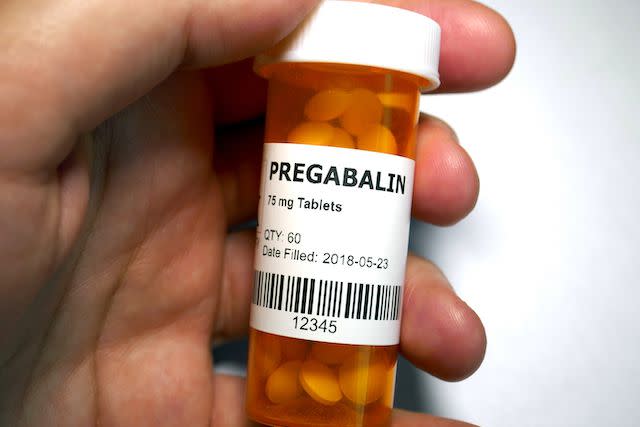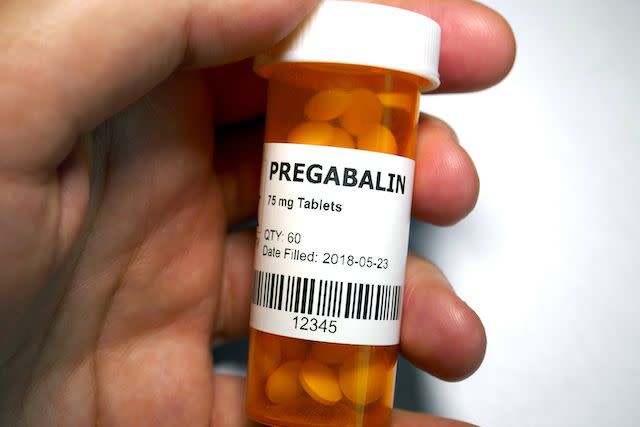Pregabalin vs. Gabapentin: What's the Difference?

Medically reviewed by Femi Aremu, PharmD
Gabapentin and pregabalin are similar drugs, but they differ in several ways. The main differences are their indications—specific uses that the Food and Drug Administration (FDA) has approved them to treat—and their dosages.
Gabapentin and pregabalin are FDA-approved to treat some of the same conditions, including postherpetic neuralgia in adults.
Both drugs are also indicated to treat partial seizures in adults and certain children with epilepsy (a seizure disorder) when taken along with other medication. Pregabalin is approved for additional uses, including fibromyalgia and nerve pain in certain adults.
Healthcare providers commonly prescribe these medications for off-label uses (non-FDA-approved uses) as well, such as anxiety disorders.
Note that pregabalin is currently approved for treating generalized anxiety disorder (GAD) in Europe, but not in the United States.
Continue reading for an in-depth comparison of pregabalin and gabapentin, including their uses, effectiveness, dosage, side effects, and more.

Differences: Pregabalin vs. Gabapentin
One of the main differences between gabapentin and pregabalin is that the FDA has approved them for some of the same indications but also some different ones.
The chart below shows the indications for which the FDA specifically approves gabapentin and pregabalin to treat:
| Gabapentin | Pregabalin |
FDA Indications | · Postherpetic neuralgia in adults · Partial seizures in adults and children (ages 3 years and older) who have epilepsy, when used along with other seizure medications | · Postherpetic neuralgia in adults |
Healthcare providers may prescribe gabapentin or pregabalin for other uses besides the conditions specified by the FDA.
Examples of off-label uses include:
GAD
Conditional anxiety (anxiety that occurs in specific situations, such as before or after surgery or chemotherapy treatments)
Gabapentin and pregabalin belong to the same drug class known as anticonvulsants. This drug class is also called antiepileptic drugs (AEDs) or simply seizure medications.
These medications work by mimicking the effects of gamma-aminobutyric acid (GABA). GABA is thought to have a calming effect and reduces nerve activity in the brain, which is believed to slow down nerve signals involved in seizures and pain.
Even though these drugs belong to the same class, pregabalin is more potent than gabapentin on a per-milligram (mg) basis. As such, pregabalin comes in lower strength than gabapentin. (See the Administration section below for more details comparing their strengths and dosages.)
Another difference is that gabapentin has been around longer. The FDA initially approved gabapentin in 1993 as the brand Neurontin.
Later, gabapentin also became available in extended-release (ER) formulations, such as Gralise.
The FDA approved pregabalin, sold under the brand name Lyrica, in 2004. An ER version of pregabalin, Lyrica CR, is also available.
Administration: Pregabalin vs. Gabapentin
This section describes the typical dosing information for pregabalin and gabapentin. Be sure to follow your healthcare provider’s instructions.
The table below compares the forms and strengths available for pregabalin and gabapentin:
Brand Name | Active Ingredient | Dosage Forms and Strengths |
Neurontin: | Gabapentin | · Oral capsule: 100 mg, 300 mg, 400 mg · Oral tablet: 600 mg, 800 mg · oral solution: 50 milligrams per milliliter (mg/mL) |
Gralise | Gabapentin | · Oral tablet: 300 mg, 600 mg |
Horizant | Gabapentin enacarbil | · ER tablet: 300 mg, 600 mg |
Lyrica | Pregabalin | · Oral capsule: 25 mg, 50 mg, 75 mg, 100 mg, 150 mg, 200 mg, 225 mg, 300 mg · oral solution: 20 mg/mL |
Lyrica CR | Pregabalin | · ER tablet: 82.5 mg, 165 mg, 330 mg |
The dosing for gabapentin and pregabalin depends on the condition being treated. Your healthcare provider will give you a lower dose when you start treatment with either drug.
Then they’ll increase it over time until they find the dosage that works for you. They may continue giving you a lower dosage in certain special situations or if you have kidney problems.
Pregabalin Dosages
Here are some examples of the typical dosages for pregabalin in adults:
Postherpetic neuralgia: 75–150 mg two times daily or 50–100 mg three times daily; maximum dosage of 600 mg daily
Nerve pain due to diabetic neuropathy: 50–100 mg three times daily; maximum dosage of 600 mg daily
Fibromyalgia: 75–150 mg twice daily; maximum 450 mg daily
Nerve pain due to spinal cord injury: 75–300 mg two times daily; maximum 600 mg daily
Adjunct treatment of partial seizures: 150–600 mg, divided into two or three doses throughout the day
Pregabalin is only approved for one use in children: partial seizures. For this use, pregabalin dosage depends on the child’s body weight.
The drug is used in children ages 1 month and older. It’s typically prescribed in combination with other seizure medications. A healthcare provider can provide details about the pediatric dosage of pregabalin.
Pregabalin may be prescribed for other uses that are considered off-label.
A healthcare provider can give you more details about pregabalin dosage for off-label uses.
Gabapentin Doses
Here are some examples of the typical doses for gabapentin in adults:
Postherpetic neuralgia: 300–600 mg three times a day; maximum dosage of 1,800 mg daily
Adjunct treatment of partial seizures: 300–1,200 mg three times daily; maximum dosage of 3,600 mg daily
To treat partial seizures in children, the dosage of gabapentin depends on the child’s body weight. The drug may be prescribed for children ages 3 years and older.
A healthcare provider can provide more details about the pediatric dosage of gabapentin. Other available versions of gabapentin are Gralise and Horizant. These brands come in ER forms that are usually taken once a day.
Gabapentin is commonly prescribed for other uses that are considered off-label. A healthcare provider can provide more details about the dosage of gabapentin for these or other off-label uses.
Warning
You shouldn’t suddenly stop taking gabapentin or pregabalin.
If you want to control the medication, consult a provider about how to stop it safely, usually by slowly reducing your dose over a couple of weeks before stopping it completely.
Efficacy: Pregabalin vs. Gabapentin
Numerous clinical trials have examined whether pregabalin or gabapentin is more effective for treating specific conditions. Some of the trial findings are explained below.
Note, however, that the results of a clinical trial may not indicate how each individual outside of clinical trials will respond to treatment.
Seizure: Some evidence suggests that pregabalin is more effective than gabapentin for treating partial seizures in people with epilepsy.
However, other studies have shown that pregabalin was not any better than gabapentin in reducing the frequency of seizures.
Note that both pregabalin and gabapentin are adjunct treatments for partial seizures, meaning that they must be taken in combination with other antiepileptic drugs (seizure medications).
Pain: A 2020 study found no significant difference in the effectiveness of pregabalin and gabapentin for treating nerve pain after spinal cord injury.
However, another study found gabapentin to be superior to pregabalin for the treatment for chronic sciatica.
Anxiety: In a small clinical trial, gabapentin was shown to be more effective for anxiety, insomnia, and fatigue symptoms in adults with low-back pain. However, the trial found that pregabalin was more effective for pain reduction.
Consult a healthcare provider if your current medication isn’t helping your symptoms. They can determine if a different dose or another drug would be more effective.
Which Drug Lasts Longer?
The chart below compares the half-life of gabapentin and pregabalin. It takes about five half-lives to clear a drug from your system.
The chart below also shows how long each drug takes to reach its maximum concentration in your blood:
Brand Name | Active Ingredient | Half-Life | Peak (how long it takes to reach maximum concentration in your blood) |
Neurontin | Gabapentin | · 5–7 hours | · 3–4 hours |
Lyrica | Pregabalin | · 6 hours | · 1–1.5 hours |
Gabapentin and pregabalin are available in immediate-release (IR) and ER versions. In general, ER versions of drugs require less frequent dosing than IR forms.
Brand names of gabapentin include Neurontin, Gralise, and Horizant.
Horizant is an ER tablet that contains gabapentin enacarbil and is approved to treat restless legs syndrome and postherpetic neuralgia.
The brand name of pregabalin IR is Lyrica; an extended-release version is Lyrica CR.
Side Effects & Safety
Examples of common side effects of gabapentin and pregabalin include:
Peripheral edema (swelling in your hands, arms, legs, or feet)
Rarely, serious side effects of gabapentin and pregabalin include:
Suicidal thoughts or behaviors
Respiratory depression (slow, shallow breathing), especially if taken with other drugs or substances that are central nervous system (CNS) depressants, such as alcohol
Allergic reactions, which may be severe
Talk to a Healthcare Provider
Gabapentin and pregabalin are not safe for everyone. Before starting gabapentin or pregabalin, talk to a healthcare provider about your health history.
This includes any surgeries, allergic reactions, and any medical conditions you have or have had, as this information helps healthcare providers determine which medications are safe for your situation.
Interactions: Pregabalin vs. Gabapentin
Pregabalin can interact with alcohol as well as other drugs.
Examples include:
Hydrocodone or other opioids
Ativan (lorazepam) or other benzodiazepines
Gabapentin can also interact with alcohol as well as other drugs. Examples include:
Benzodiazepines
Opioids
Antacids, such as Maalox (magnesium/aluminum hydroxide), can slightly reduce the concentration of gabapentin
Morphine can increase the concentration of gabapentin
Summary
Gabapentin and pregabalin are similar drugs but differ in their indications (uses that the FDA has approved them to treat) and their dosages.
Also, pregabalin is a controlled substance; gabapentin is not. Both drugs are used to treat certain types of nerve-related pain in adults.
They’re also both used to treat seizures in adults and children. Talk to a healthcare provider to determine if one of these medications may be right for you.
Frequently Asked Questions
How do I store pregabalin vs. gabapentin?
The storage requirements for pregabalin and gabapentin depend on the form of the drug. Both drugs' oral tablets and capsule documents should be stored at room temperature.
The oral liquid solution of pregabalin can also be kept at room temperature, but the gabapentin oral solution should be refrigerated. Additionally, keep all medications out of the reach of children and pets.
Are both of these drugs designated as controlled substances?
Pregabalin is a Schedule V controlled substance that carries risks of misuse, abuse, or addiction.
Gabapentin is not considered a controlled substance. In a research study comparing the potential for addiction, neither gabapentin nor pregabalin were found to be particularly addictive.
However, the researchers concluded that pregabalin seemed “somewhat more addictive” than gabapentin due to the greater extent of behavioral changes that may indicate dependence on pregabalin use.
Is pregabalin or gabapentin considered a strong painkiller?
The term “painkiller” is often used to describe opioid pain medications such as codeine. Pregabalin and gabapentin are not opioids. However, they can be used to treat nerve-related pain called neuropathy, and they work in a different way than opioid painkillers.

